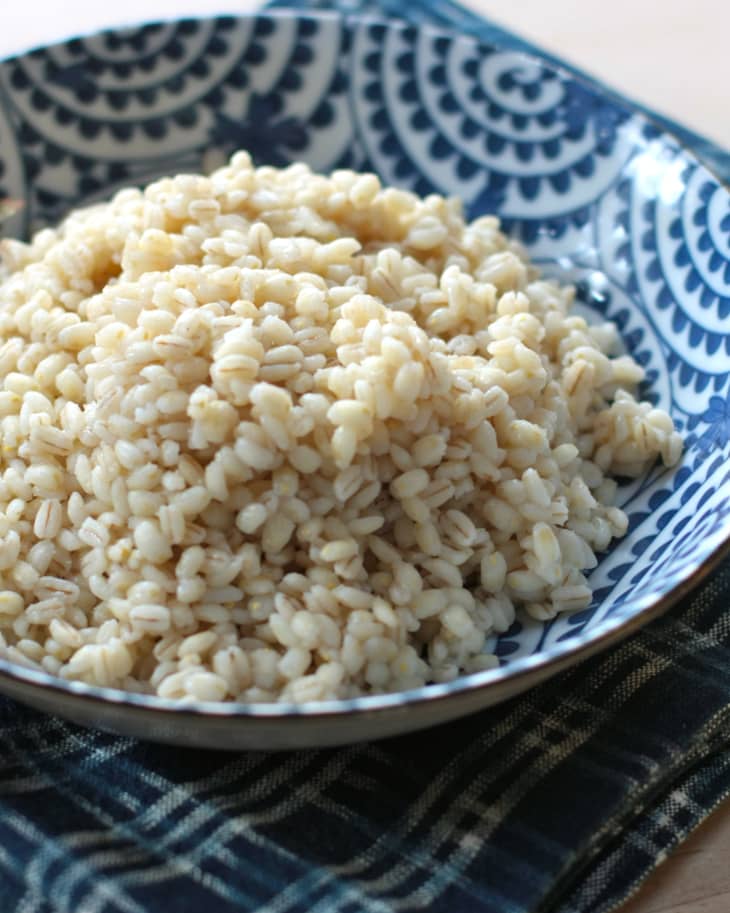How To Cook Tender, Chewy Barley

Barley is one of those wonderful grains that doesn’t get the attention it deserves. With a chewy texture and nutty flavor, barley is a delicious whole grain that can be used in a number of ways, way beyond the classic beef and barley soup. It is also a very nutritious and healthy food, with lots of fiber and a number of trace minerals like selenium, manganese and phosphorus.
Hulled Barley vs Pearl Barley
The most important thing to know about barley is that it comes in two basic forms: hulled and pearl. Hulled barley has had the tough, inedible outermost hull removed but still retains its bran and endosperm layer. It is the most nutritious of the two and can be considered a whole grain. A light golden brown in color, it’s the nuttier and chewier version as well.
Pearl barley has been polished to remove the bran and possibly even the endosperm layers, resulting in a pale, creamy-colored grain. It is less chewy and cooks faster than the hulled variety, but has less fiber, is less nutritious, and is not considered a whole grain. Most people are familiar with pearl barley, especially as an ingredient in beef-barley soup.
Both kinds of barley are traditionally simmered in water, or for more flavor, stock. One cup of hulled barley will yield three cups cooked. Hulled barley can take 20 to 25 minutes longer to cook than pearl and will absorb less liquid. It will retain its shape and swell with cooking, resulting in individual, separate grains. It is delicious as a pilaf or as an alternative to wheat berries in whole grain salads.
Pearl barley is softer and releases starch into its cooking liquid, making it a good thickener for soups. (If you don’t want pearl barley to thicken your dish, cook it separately and rinse it before adding.) For this same reason, it can also be made risotto-style, resulting in a creamy, chewy dish.
The Best Way To Buy Barley
The best way to purchase barley is from bulk bins at stores like Whole Foods so you can be assured that the supply is fresh. As with all bulk grains, it’s best to give the barley a quick rinse under running water before cooking to wash away any dust or debris. Barley can also be purchased prepackaged in boxes or plastic bags at any decently stocked grocery store.
Recipes with Barley
How To Cook Barley
Nutritional Info
Ingredients
- 1 cup
pearl or hulled barley
- 3 cups
water or stock
Salt (optional)
Equipment
Measuring cup
2-quart sauce pan with lid
Strainer
Instructions
Combine the barley and water: Combine the barley and water in the saucepan. Add a generous pinch of salt if desired.
Bring to a boil: Bring the water and barley to a boil over high heat. Keep an eye on the pot as barley will give off a lot of foam at first and can cause the pot to boil over.
Simmer the barley: When the barley has reached a boil, lower the heat to a low simmer, cover, and continue to cook until the barley is done. For pearl barley, start checking at 25 minutes. For hulled barley, start checking at 40 minutes. The barley is done when it has tripled in volume and is soft yet chewy. Add more water if the pan becomes dry before the barley has finished cooking; check every 5 minutes until desired chewiness is reached.
Drain the barley (if necessary): When the barley is done, it will have absorbed most of the water. If there is a little water still left in the pot, just leave the barley to sit for 10 minutes, covered, until it has all been absorbed. If there is a lot of water left, drain the barley in a strainer over the sink.
Fluff the barley: With a fork, fluff the barley to separate the grains. Enjoy!
Recipe Notes
To cook more or less barley, use this ratio of 1 cup barley to 3 cups water.
